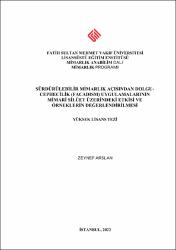Sürdürülebilir Mimarlık Açısından Dolgu-Cephecilik (Facadism) Uygulamalarının Mimari Silüet Üzerindeki Etkisi ve Örneklerin Değerlendirilmesi
Künye
ARSLAN, Zeynep, Sürdürülebilir Mimarlık Açısından Dolgu-Cephecilik (Facadism) Uygulamalarının Mimari Silüet Üzerindeki Etkisi ve Örneklerin Değerlendirilmesi, Fatih Sultan Mehmet Vakıf Üniversitesi Lisansüstü Eğitim Enstitüsü Mimarlık Anabilim Dalı Mimarlık Programı, Yayımlanmamış Yüksek Lisans Tezi, İstanbul 2023.Özet
Geçmişten günümüze ulaşan, farklı toplumların ihtiyaçlarına ve mimari anlayışlarına göre şekillenen mekanlar, tarihi çevreyi oluşturmaktadır. Toplumun zaman içerisinde değişen kültürel, ekonomik ve sosyal yapısı tarihi çevreninde şekillenmesinde etkili olmaktadır. Bunun yanında bu etki yapılı çevreyi oluşturan unsurların panoramik resmi olarak tanımlanan mimari silüetin oluşmasında rol oynamaktadır. Ayrıca günün ihtiyaçlarına uygun çağdaş yapılar ile tarihi yapıların bir araya gelmesiyle geleneksel mimari silüet değişim içerisine girmektedir.
18. ve 19. yüzyıllarda yeni buluşların etkisiyle meydana gelen Sanayi Devrimi belli bölgelerde sosyoekonomik gelişimi sağlamış ve göç dalgasına neden olmuştur. Göç dalgaları nedeniyle kentleşmenin hızla artması geçmiş ile bağlantı kurmamızı sağlayan kültürel varlıklara zarar vermeye başlamıştır. Adını ilk kez Birleşmiş Milletler Konferansı‟nda duyuran sürdürülebilirlik, enerji kaynaklarının dengeli kullanımını sağlamak amacıyla ortaya çıkmıştır. Ancak ilerleyen süreçte sürdürülebilirlik, tarihi çevre mimarisini kapsayacak şekilde doğal düzenin korunması ve kaynakların kendini yenileme özelliğinin zarar görmemesi için önemli bir kavram haline gelmiştir. Sürdürülebilirlik ile tarihi çevreyi oluşturan yapıların ekonomik, kültürel ve çevresel kalkınması amaçlanmaktadır.
Tarihi çevrenin sürdürülebilirliğini ve gelişimini sağlayan birçok uygulama bulunmaktadır. Dolgu ve cephecilik (facadism) ise doğru kararlar verilerek uygulandığı sürece bu uygulamaların en önemlilerindendir. Boş arazide ve tarihi
vi
cephe arkasında yeni yapılaşma amacı güden bu uygulamalar farklı dönemlerde inşa edilen yapıların birikimiyle oluşan mimari silüetide etkilemektedir. Tez çalışması kapsamında; dolgu ve cephecilik uygulamaları ile sürdürülebilir mimarlık ilişkisi üzerinde durulmuştur. Uygulamaların mimari silüetin sürdürülebilirliğine ve gelişimine etkisi tasarım ögeleri olan cephe, kütle ve form başlıkları altında incelenmiştir. The spaces that have reached the present from the past and are shaped according to the equipment and architectural understanding of different societies form the historical environment. The changing cultural, economic and social structure of the society over time is effective in shaping the historical environment. In addition, this effect plays a role in the formation of the architectural silhouette, which is defined as the panoramic picture of the elements that make up the built environment. Also, the traditional architectural silhouette undergoes a change with the combination of contemporary buildings suitable for the needs of the day and historical buildings.
The Industrial Revolution, which occurred with the effect of new inventions in the 18th and 19th centuries, provided socioeconomic development in certain regions and caused a wave of migration. The rapid increase in urbanization due to migration waves has begun to damage the cultural assets that allow us to connect with the past. Sustainability, which made its name known for the first time at the United Nations Conference, emerged in order to ensure the balanced use of energy resources. However, in the following process, sustainability has become an important concept for the preservation of the natural order, including the historical environmental architecture, and for not harming the self-renewal feature of the resources. Sustainability is aimed at the economic, cultural and environmental development of the structures that make up the historical environment.
There are many applications that ensure the sustainability and development of the historical environment. The infill and the facadism are important practices as long as they are applied by making the right decisions. These applications, which aim for new construction on the empty land and behind the historical facade, also affect the architectural silhouette formed by the accumulation of buildings built in different periods. Within the scope of the thesis; The relationship between the infill and the facadism applications and sustainable architecture is emphasized. The effects of the applications on the sustainability and development of the architectural silhouette are examined under the design elements of facade, mass and form.



















